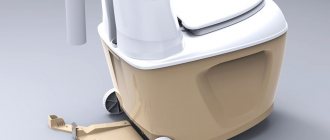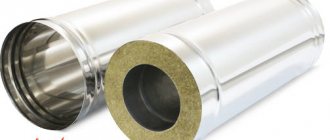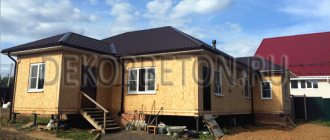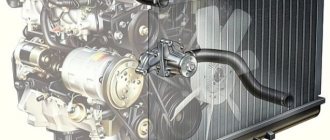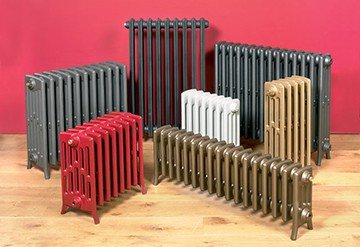
Even after a fleeting acquaintance with the copper and aluminum splendor displayed in the window, the owners of cast-iron batteries risk losing sleep and appetite.
But how, after all, to decide which radiator is better: copper or aluminum?
In this article we will weigh all the pros and cons and find out the winner.
Advantages and disadvantages of an aluminum radiator
Aluminum batteries are of two types:
- Cast: aluminum is better than other metals compatible with injection molding technology, which manufacturers successfully use. The cast radiator turns out to be one-piece, and therefore as durable as possible.
- Prefabricated welded: such batteries are made from a profile that is obtained by pressing an aluminum billet (extrusion method). Each section consists of two parts welded together. The radiator is assembled from several sections, fastened to one another by means of a thread. Such devices are less durable than cast ones.
The popularity of aluminum radiators is due to the following advantages:
- Great appearance.
- High thermal conductivity - the heat transfer of the section can reach 212 W.
- Light weight: with dimensions 80x80x380 mm, the section weighs only 1 kg.
- The product is guaranteed for a period of 10 to 20 years.
Due to the addition of silicon, the strength of modern aluminum radiators is quite acceptable: you can easily find a model designed for pressures up to 16 atm. And some manufacturers produce radiators that can operate at a pressure of 24 atm.
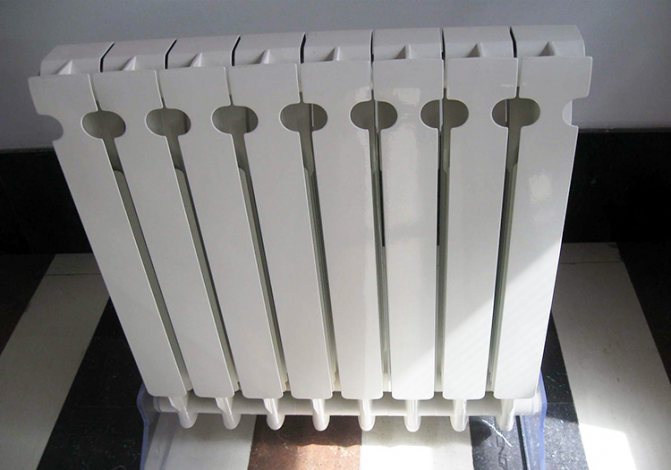

Aluminum heating coil
Aluminum batteries also have disadvantages:
- They do not like high temperatures - the coolant should not be hotter than 110 degrees.
- Corrosion susceptibility.
Prefabricated models cannot be used in systems in which antifreeze acts as a working environment.
Advantages and Disadvantages of Copper Heatsink
Today, for the manufacture of a copper radiator, only the purest copper is used: according to the technology requirements, the amount of impurities should not exceed 0.1%. This approach provides the following benefits:
- High thermal conductivity of the material, resulting in an equally high heat transfer.
- Good durability, allowing the device to work in systems with high pressures - up to 16 atm.
- High corrosion resistance.
- The ability to maintain working qualities at coolant temperatures up to 250 degrees.
It is possible to connect a copper radiator to the pipeline either by means of a threaded connection or by means of soldering. Thanks to this versatility, the cost of installation work can be significantly reduced.


Copper heating radiator
Another important advantage of copper is its high ductility at low temperatures. If a filled heating system freezes, then the copper elements will only deform, but will not burst.
Copper radiators, unlike steel appliances, are not afraid of the effects of chlorine salts, which are very often found in our heating systems in fairly abundant quantities.
All of the listed advantages determine the durability of this type of heating devices.
At the same time, the buyer should take into account some disadvantages:
- High cost - a copper radiator costs about 4 times more than a steel one.
- Simultaneous connection of such devices with galvanized steel pipes in the direction of movement of the working medium is not allowed - the electrochemical reaction that occurs in this case can cause destruction of the material.
- It is undesirable to use copper batteries in systems where the coolant contains a large amount of hardness salts or has a high acidity.
Problems can be avoided if copper batteries are connected to steel pipes using brass adapters.
Specific heat of aluminum
The specific heat capacity of aluminum depends significantly on temperature and at room temperature is about 904 J / (kg deg), which is much higher than the specific (mass) heat capacity of other common metals, such as copper and iron.
Below is a comparative table of the specific heat values of these metals. The heat capacity values in the table are in the temperature range from -223 to 927 ° C.
The table shows that the value of the specific heat of aluminum is much higher than the value of this property for copper and iron, therefore, such a property of aluminum as the ability to accumulate heat well, is widely used in industry and heat engineering, making this metal indispensable.
Presented are tables of thermophysical properties of silver Ag depending on temperature (in the range from -223 to 1327 ° C). The tables give properties such as density ρ
, specific heat of silver
C p
, thermal conductivity
λ
, electrical resistivity
ρ
and thermal diffusivity
but
.
The reliability of the auxiliary materials should be as low as that of the base material. From a cracking point of view, a limited amount of water can be installed. Chemical design is also important for materials operating at elevated temperatures.
Typically, the welding properties of the weld are selected. Additional materials are supplied in the form of beads, pipes, ribbons, electrodes and the like. Due to the high quality requirements for welded joints with neighboring materials, their properties are classified in the relevant standards and are required with appropriate certification. Therefore, manufacturers guarantee the required properties, but all precautions must be taken for the recommended storage and use of auxiliary materials.
Silver is a pretty heavy metal - its density at room temperature is 10493 kg / m 3.
When silver is heated, its density decreases as this metal expands and its volume increases. At a temperature of 962 ° C, silver begins to melt. The density of liquid silver at the melting point is 9320 kg / m 3.
Area subject to heat
In the case of thermally untreated and cold-formed materials, there is a change in recrystallization and heat recovery during mashing. In addition, a coarse grain structure can also be formed. Thus, the deterrent state is least susceptible to harvest.
Heat treated alloys generally retain their strength by spraying or dissolving precipitated phases. The sensitivity of the curing material significantly affects the degree of loss of strength. Once harvested, most materials cannot maintain the cooling rate required to create suitable aging conditions, so the strength of the untreated base material can no longer be achieved.
Silver has a relatively low heat capacity compared to. For example, the heat capacity is 904 J / (kg deg), copper - 385 J / (kg deg). The specific heat of silver increases upon heating. Its behavior for this metal in the solid state is similar to that for copper, but the jumps in the heat capacity upon melting have opposite directions. Overall growth C p
to the melting point in comparison with the classical value, is about 30%.
These alloys are known for their low sensitivity to curing, that is, to.the strength achieved after aging is slightly dependent on the cure rate. This means that cooling this material results in air cooling to achieve strength values as in this moderate condition.
This type of alloy is therefore called self-synchronization. If necessary, please make sure that you have obtained the necessary knowledge from this paragraph. Aluminum in various minerals forms 8% of the earth's crust, which is the third most abundant element of oxygen and silicon. Aluminum is non-magnetic and is often used in magnetic X-ray machines to prevent damage to the magnetic field. This is because aluminum reacts with oxygen to form a thin, protective oxide layer. Aluminum is 100% recyclable and does not lose its original properties in this process. Secondary aluminum requires 5 percent of the energy required to produce primary aluminum. About 75 percent of all aluminum ever made is still used in Europe to recycle about 70 percent of aluminum cans, and used cans will be new in less than 60 days.
- Aluminum does not occur naturally in its metallic form.
- Aluminum is not corrosion-resistant and corrosion-resistant.
Which heater radiator is better: copper or aluminum?
As you can see, copper and aluminum radiators are very similar to each other. They are lightweight and have excellent design and increased heat dissipation. The latter quality allows the user to reduce the volume of the heating circuit and apply the temperature regime 80/60 (supply / return) instead of 90/70 without increasing the area of the radiators.
Both types of radiators, due to their low heat capacity, have low thermal inertia, which allows the boiler to remain in optimal mode during warming outside.


Aluminum batteries in the interior
At the same time, both copper and aluminum are soft metals, and therefore they do not tolerate the presence of solid mechanical impurities in the coolant that have an abrasive effect.
At the same time, one cannot fail to notice that aluminum radiators are in many ways inferior to copper ones. We have already said above that high temperatures are contraindicated for them. To this can be added the ability to self-breathe: specific chemical processes lead to the formation of air locks, which periodically have to be vented.
Prefabricated aluminum radiators do not tolerate water hammer that occurs in heating systems during a sharp change in weather.
In addition, with frequent changes in temperature conditions, aluminum in contact with steel suffers from a significant difference in the coefficients of thermal expansion of these materials. For this reason, they are best used in regions with consistently cold winters.


Powerful copper heatsink
And the last thing is corrosion. In the heat supply conditions usual for us, aluminum is short-lived - it needs a coolant with a pH of 7 or 8.
Thus, copper radiators can be considered less moody.
It would seem that there are many varieties of heating batteries, but new items are still appearing. Vacuum heating radiators: device and varieties, as well as prices for devices.
An overview of manufacturers of cast iron radiators can be found here.
And in this article https://microklimat.pro/sistemy-otopleniya/montazh-sistem-otopleniya/sxemy-podklyucheniya-radiatorov.html the diagrams for connecting heating radiators are presented, as well as recommendations for the place of their installation.
Definition and meaning
Thermal conductivity is the ability of materials to transfer heat energy from heated surfaces to cold areas. Liquids, gases, solids can be thermally conductive. This is the body's ability to conduct heat energy through itself, transfer it to other objects.
The coefficient of thermal conductivity is a value equal to the amount of heat that is transferred through a certain surface area in 1 second.
This parameter was first established in 1863. Scientists have proven that heat transfer is carried out by the movement of free electrons. There are more of them in metal blanks than in objects made of other materials.
Testimonials
When studying the discussions on the pages of online forums, no complaints about copper or aluminum radiators were found.
True, not many can afford copper radiators - the price of a device designed for heating 20 - 25 sq. m, reaches 23 thousand rubles.
Due to such a high cost, such devices have not become widespread, so there are many false rumors about them.
For example, some have expressed concern that copper will turn green, as happens with copper roofs or monuments.
Connoisseurs reassure: a greenish oxide (patina) is formed only with prolonged exposure to high humidity.
Many people consider aluminum batteries to be too light and unreliable, but they are being used more and more often. Aluminum heating radiators: technical characteristics, advantages and disadvantages, as well as types of structures.
Why do you need a thermostat for a heating radiator, how to install it and which one is better to choose, read in this topic.





